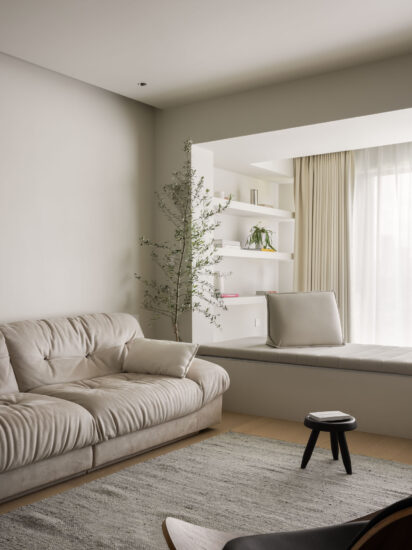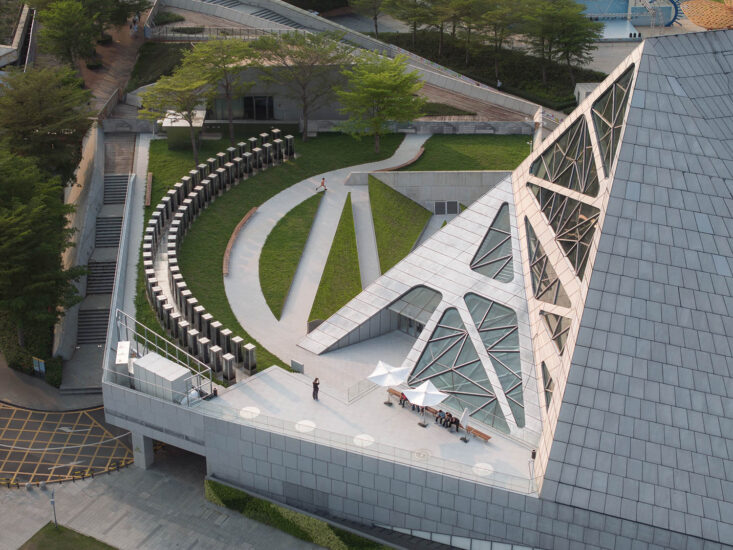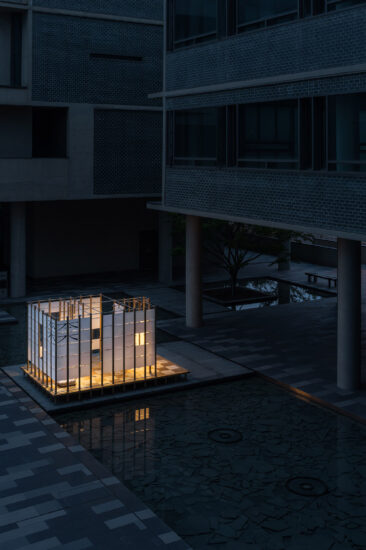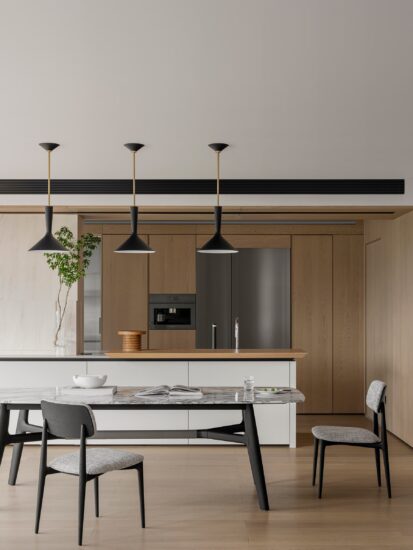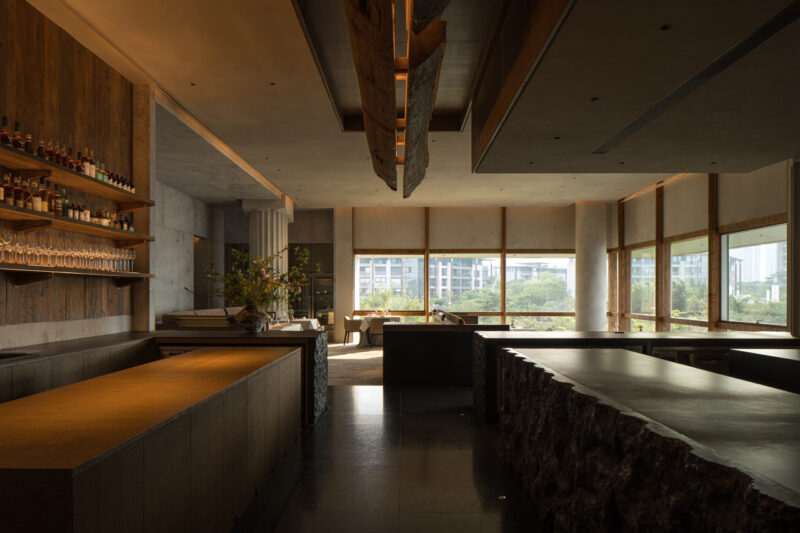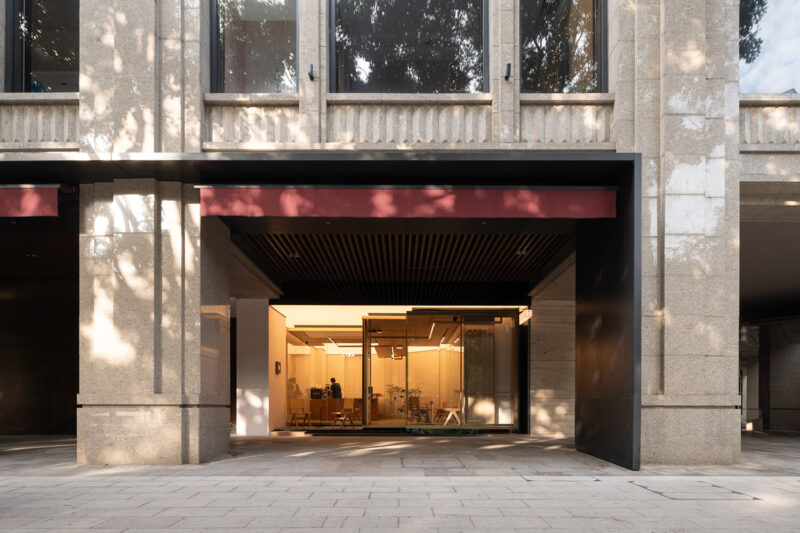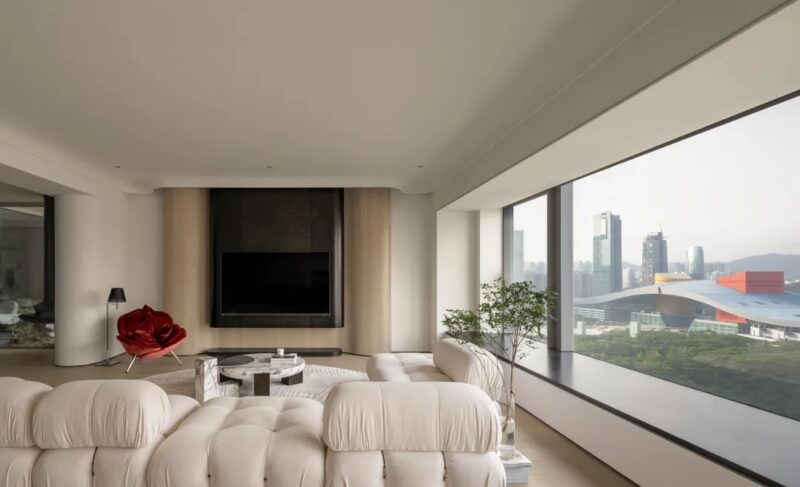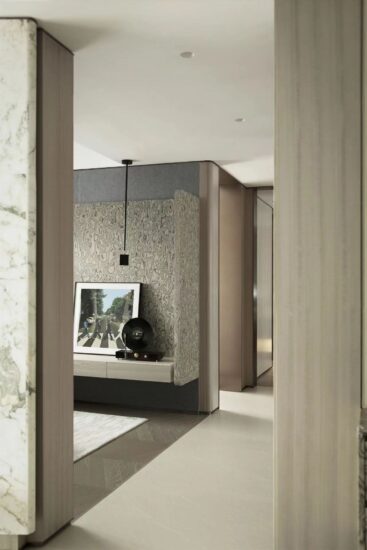以当代艺术的理念营建乡村公共空间——深圳坪山长守村“软广场”建筑装置
Constructing Rural Public Spaces with the Concept of Contemporary Art
— “Soft Square” in Changshou Village, Pingshan, Shenzhen
∇ 鸟瞰“软广场” © 张超
Aerial view of the “Soft Square” © Zhang Chao
一、序言
Preface
当下中国乡村振兴的核心策略,便是依托城市的反哺效应,通过旅游业的发展为乡村带来活力,进而带动资金、产业、文化的进入,有效促进乡村人口的回流和外来人口的定居。
China’s rural revitalization initiative emphasizes leveraging urban resources to support rural development. A key strategy involves developing tourism to attract capital and industries, foster cultural engagement, promote population retention, and facilitate the settlement of new residents in rural areas.
其中,文化项目入驻乡村成为了一种全新尝试。中国著名的文艺团体——龙马社在深圳坪山长守村建立戏剧公社,形成常态的乡村艺术表演基地,从事戏剧的创作、排练和演出。为配合戏剧公社的进驻,朱小地建筑师受邀承担了长守村统筹规划及重点范围的设计工作。
Integrating cultural projects into rural settings is a new attempt in this regard. In Changshou Village, located in the Pingshan District of Shenzhen, the esteemed Chinese performing art studio, Longma Studio, has embarked on an experimental endeavor to establish a theater commune. This commune is intended to serve as a hub for regular rural art performances, encompassing the entire process from creation and rehearsal to staging dramas. To support this endeavor and accommodate the increasing number of audiences and tourists, architect Zhu Xiaodi was commissioned to steer the village’s overall planning and the design of key areas.
∇ 龙马社长守村戏剧公社剧场开幕大戏《我爱桃花》© 龙马社
A poster of the play “I Love Peach Blossom” by Longma Studio, to be staged at the Theater Commune nestled in Changshou Village © Longma Studio
二、走进长守村
Site Overview
长守村坐落于深圳东北部坪山丘陵之中,演出的地点确定在长守村内原有的传统客家民居——江氏围屋。该围屋始建于清乾隆年间,占地面积8000平方米。背靠山体,面对水塘,是广东民居的典型布局。如今,围屋部分建筑仍保持着往昔的完整风貌,另一部分遭到了拆毁。
Changshou Village is situated in a hilly area of Pingshan in northeast Shenzhen. The performance venue is positioned in Jiang’s Hakka Houses, a traditional architectural complex in the village. Built during the Qianlong period of the Qing Dynasty, this 8,000-square-meter compound features a typical Cantonese residential layout, nestled against a mountain and embracing a pond. While parts of the houses remain intact, others have been demolished.
∇ 江氏围屋与水塘鸟瞰 © 侯丹青
Aerial view of Jiang’s Hakka Houses and the pond in front © Hou Danqing
从空中观察长守村的空间格局,可以发现长守村还保留着农耕文明的形态——各家各户的房屋自成体系,道路系统相对狭窄,缺乏必要的空地和相应的公共空间。村口、街巷、水塘等本身也很局促,再加上几十年市场经济的洗礼,如今已失去了往日凝聚人气的魅力。
The aerial views of Changshou Village reveal its spatial fabric shaped by agricultural roots, showing independent house systems of each household, narrow roads, and a lack of open public spaces. Over the decades, the originally cramped village entrance, streets, lanes, and pond have lost their charm of gathering people due to the impact of the market economy.
围屋前面的水塘,现已租赁给私人作为鱼塘使用,原本的岸线被石头和混凝土所取代,为了防止人员或者车辆的不慎落水,水塘周围还安装了不锈钢栏杆,彻底改变了水塘的原貌和在村落中的地位。这些变化与乡村质朴的基调格格不入,构成了一种不可逆的景观破坏,无形中加剧了乡村公共空间的割裂感,让人变得更加疏离与麻木。
The pond in front of the Hakka houses was leased as a private fish pond. Its natural shoreline was replaced by stone and concrete, and stainless steel railings were installed along its periphery to protect pedestrians and vehicles’ safety, fundamentally changing the pond’s appearance and role in the village. These alterations clashed with the rural settings and disrupted the natural landscape, causing a sense of alienation in the rural public space.
∇ 水塘现状 © 朱小地
The pond before construction © Zhu Xiaodi
龙马社的戏剧演出一定会对长守村、坪山乃至深圳产生巨大的影响和聚集效应,成为重磅文化事件,激发起人们观演戏剧,参与乡村文化生活的热情。然而,演出的常态化将带来游客数量的激增,对长守村原本有限的公共空间构成了不小的挑战。如何容纳庞大的游客群体,避免本地居民与外来游客之间的潜在冲突,成为了亟需解决的问题。
Longma Studio’s performances are expected to significantly impact Changshou Village, Pingshan District, and even broader Shenzhen, potentially evolving into a major cultural event that ignites local interest in drama and rural cultural life. Meanwhile, this will bring anticipated influx of tourists, posing challenges to the already cramped public spaces in Changshou Village. How to accommodate these visitors while mitigating potential conflicts between local villagers and tourists has become an urgent concern.
∇ 龙马社长守戏剧公社 © 张超
Longma Studio Theater Commune in Changshou Village © Zhang Chao
南方丘陵地区的水塘在传统村落中扮演着重要角色,它不仅承载着村民的取水、洗衣、防火等功能,同时兼具景观和风水寓意,是村落中重要的公共空间与情感纽带。现在,日益城市化的生活方式使得水塘逐渐失去原有的功能,沦为孤立的“鱼池”,其生硬的边界更是阻拦了视线的延伸和亲水的可能,也就无法形成公共性和各种交往活动的发生。
In the past, ponds played a vital role in traditional villages in the hilly regions of Southern China. They served as sources of drinking water, washing, and fire prevention. Additionally, they provided landscape and Feng Shui benefits, and were essential public spaces and emotional bonds within the village. However, due to urbanized lifestyles, ponds have become isolated “fish ponds,” with rigid boundaries cutting off visual and physical access to water, limiting public availability and interaction.
简单地恢复水塘原来的岸线,既不可行也缺乏现实意义。而拆除水塘边的栏杆,又会影响到村民和游客的安全。同时,随着外来游客和观众的增多,他们来此不仅是为了观赏戏剧,更渴望深入了解乡村文化,体验并融入乡村生活。
Merely restoring the pond’s original shoreline is neither feasible nor practically meaningful. Removing the railings would compromise the safety of villagers and tourists. Additionally, the increasing number of visitors necessitates more public spaces, not only to accommodate their interest in drama but also to allow them to experience and immerse in rural life.
2023年8月,朱小地和他的团队来到围屋所在地,在对围屋前的水塘进行调研和分析的基础上,提出了空间提升的方案,并得到了坪山市政府和龙马社的高度认可。
In August 2023, architect Zhu Xiaodi and his team visited the site and proposed a space improvement plan based on their investigation and analysis of the pond. This scheme received strong support from the Pingshan Government and Longma Studio.
三、“软广场”的诞生
Creation of a “Soft Square”
朱小地提出了在水塘上构建一张巨大的绳网编织结构的设想,这个装置是平的,与周边道路之间的完美衔接,如同扩展出一片新的广场,成为村落新的公共空间。绳网材料具有极低的延展性和高达90KN的破断拉力,可以承载人们在上面自由行走、驻足、或坐或躺。这样的设计不仅创新了公共空间的营建方式,也为村民与游客提供了亲近自然、放松身心的独特享受。于是,这个建筑装置有了属于自己的名字:“软广场”。
Zhu Xiaodi’s innovative concept involves constructing a large woven rope net structure over the pond. This installation seamlessly integrates with the surrounding roads, creating an expansive square that becomes a new public space in the village. The rope net, made of ultra-low-ductility material with a tensile strength of up to 90KN, can support various activities such as walking, standing, sitting, or lying down. This design offers an innovative way of constructing public space, providing a unique experience for tourists and villagers to relax and commune with nature. This architectural installation is aptly named “Soft Square.”
∇ 绳网装置效果图 © ZXD Architects
Rope net installation rendering © ZXD Architects
此处内容需要权限查看
会员免费查看






